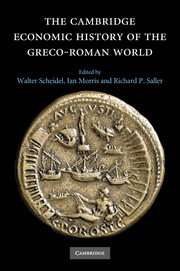Book contents
- Frontmatter
- 1 Introduction
- Part I Determinants of Economic Performance
- Part II Early Mediterranean Economies and the Near East
- Part III Classical Greece
- Part IV The Hellenistic States
- Part V Early Italy and the Roman Republic
- Part VI The Early Roman Empire
- Part VII Regional Development in the Roman Empire
- 24 The Western Provinces
- 25 The Eastern Mediterranean
- 26 Roman Egypt
- 27 The Frontier Zones
- Part VIII Epilogue
- Bibliography
- Index
- Map 1.1 The Mediterranean basin"
- Map 10.1 Greek and Phoenician trade in the period of the Persian Wars"
- Map 11.1 The Achaemenid empire"
- Map 12.1 Greece and Asia Minor"
- Map 15.1 The Seleucid empire"
- Map 16.1 Greco-Roman Egypt"
- Map 20.1 The Roman empire at the accession of Vespasian"
- References
24 - The Western Provinces
from Part VII - Regional Development in the Roman Empire
Published online by Cambridge University Press: 28 March 2008
- Frontmatter
- 1 Introduction
- Part I Determinants of Economic Performance
- Part II Early Mediterranean Economies and the Near East
- Part III Classical Greece
- Part IV The Hellenistic States
- Part V Early Italy and the Roman Republic
- Part VI The Early Roman Empire
- Part VII Regional Development in the Roman Empire
- 24 The Western Provinces
- 25 The Eastern Mediterranean
- 26 Roman Egypt
- 27 The Frontier Zones
- Part VIII Epilogue
- Bibliography
- Index
- Map 1.1 The Mediterranean basin"
- Map 10.1 Greek and Phoenician trade in the period of the Persian Wars"
- Map 11.1 The Achaemenid empire"
- Map 12.1 Greece and Asia Minor"
- Map 15.1 The Seleucid empire"
- Map 16.1 Greco-Roman Egypt"
- Map 20.1 The Roman empire at the accession of Vespasian"
- References
Summary
The western provinces can be divided into two zones according to their relationship to Rome, the center of power: a Mediterranean zone in which contacts via the sea prevailed, and a continental and oceanic zone separated by the Alps from Italy. They comprise the Libyan, Iberian, Celtic, and Germanic linguistic zones where Latin, the language of administration imposed by the conqueror, also became the idiom of culture. Since they had never been part of the great Hellenistic empires, their population had no experience of state organizations. With a few notable exceptions, administrative practices characteristic of ancient cities were recent and Roman in origin.
These territories were thus new zones open to Roman initiatives. This marks a first difference in character compared with the east where exploitation had started earlier. Moreover, our written sources for understanding the economy are less abundant and particularly so for the continental sector. They favor the urbanized coastal areas of the Mediterranean, the sectors of the economy where the state intervenes – the emperor’s laws and administration – and areas of military interest.
Our knowledge of regions that were less urbanized, less subject to administrative control, and not affected by military operations is mainly dependent on archaeological sources which are difficult to organize and use as evidence for economic history. Nevertheless, these sources are primarily responsible for the striking increase in our knowledge of the provinces of continental Europe over the last twenty years. Our understanding of rural settlement patterns has been profoundly altered by the introduction and increasingly general practice of landscape archaeology and rural field surveys.
- Type
- Chapter
- Information
- The Cambridge Economic History of the Greco-Roman World , pp. 649 - 670Publisher: Cambridge University PressPrint publication year: 2007
References
- 12
- Cited by



